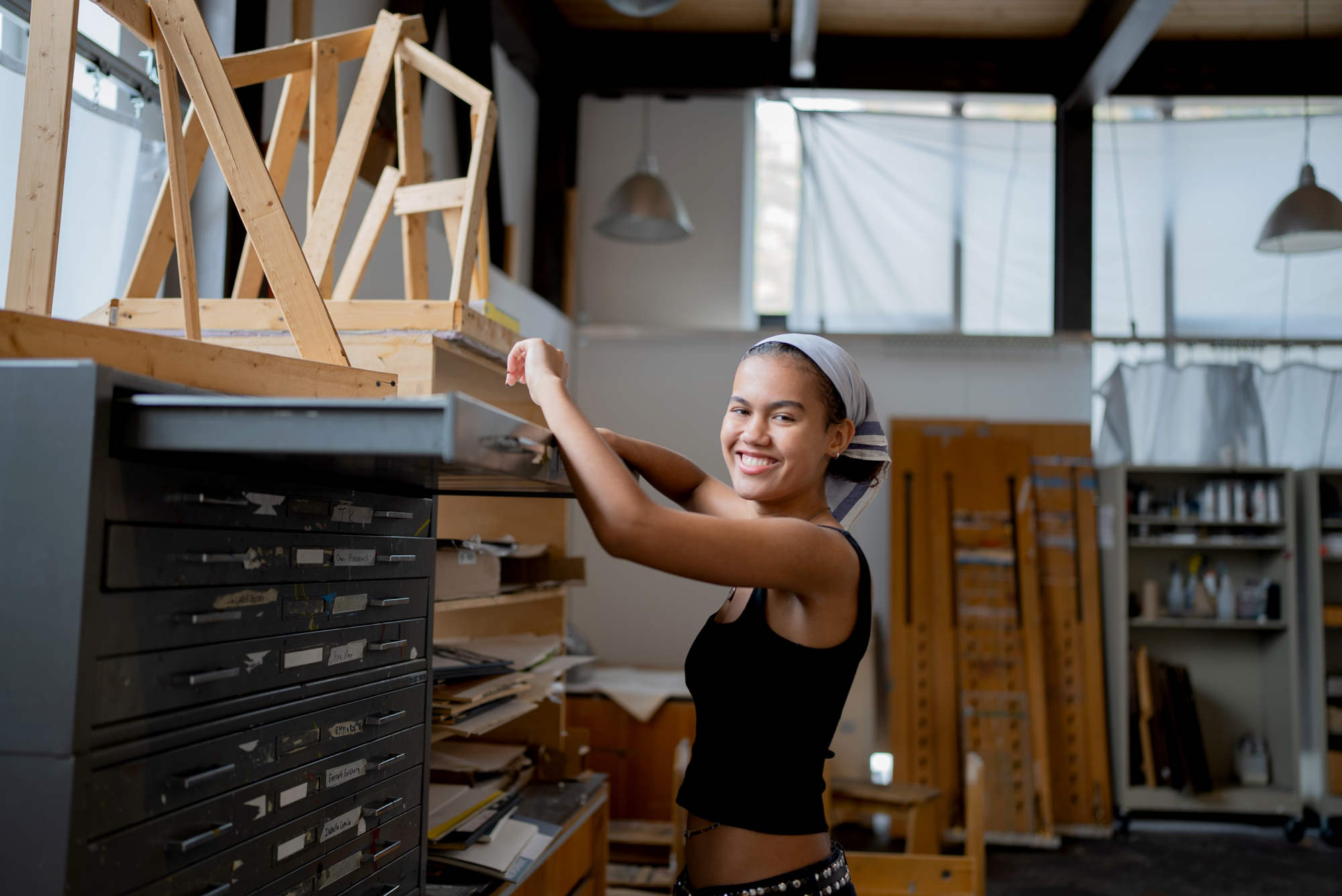Art imitates life
Jolie Saint Vil ’27 celebrates her Haitian heritage through family legacy painting.

PhotoGRAPH by Genamarie McCant
For first-year student and art major Jolie Saint Vil ’27, her sanctuary is Williams Visual Arts Center. It’s more than just studio space to practice her craft of painting portraits—it’s where she’s both connecting with her past and dreaming up goals for her future.
Saint Vil, who grew up in New York, was determined from a young age to preserve the memories and ancestral stories of her Haitian ancestors; there are few photographs and documentation of her heritage, but through painting her relatives she is able to provide a timeless extension of her family’s history, and her own, to be passed down for generations.
We spoke with Saint Vil about her passion for family legacy painting, what makes this form of artwork so powerful, and how the College is contributing to her development as an emerging artist.

Why were you drawn to family legacy painting?
I have always loved stories and storytelling. As I grew up, this fascination shifted to my own family history and stories. I would see a box of old pictures and want to know everything about the people in them, and as an only child, I felt like it was my responsibility to ask questions and remember my family’s stories in order to pass them down. As my painting skills developed and I thought about what I wanted to paint, I envisioned these stories and how I wanted to tell them.
My paintings help me think about all of the people that came before me and will come after me. It brings me closer to the people I love. I want to visualize the experiences of the nameless or invisible, starting with the Haitian side of my own family.
“My paintings act as a way for me to remember my ancestors and be remembered by the world.”
JOLIE Saint Vil ’27
What makes legacy artwork so powerful?
Legacy artwork can convey pride and value to a group of people. It’s an interesting case of double consciousness. My work explores the parts of stories intentionally left out by society, like the innocence and joy of childhood, which is so often unacknowledged when depicting Black families. With my art I aim to shift the perspective on what or who is considered “portrait-worthy” and what aspects of their lived experiences are highlighted. Our family is proud, and it is so important to me that the world sees just how amazing we are: hardworking, intelligent, talented, and strong.
I created a painting of my dad and his two older brothers during my senior year of high school titled Fres Saint Vil Yo. It was my first large-scale painting, and the subject matter is rare—it is one of very few pictures of my dad and his brothers as kids. The exhibition of this piece created a special moment for my family where they could see themselves and feel proud; it also led to them sharing childhood memories that I’ve never heard before.
Tell us about the painting of your late grandmother (pictured, below).
My grandma was incredibly humble and hardworking. She sacrificed her life and left her children behind in Haiti to work and send money back for them to get a good education and then come to America for a chance at a better life. The picture I used for reference is one that I saw at my uncle’s house. When I saw it, I immediately knew that I had to paint it. I had never seen a picture of her where she looked so beautiful and sure of herself, and I wanted to immortalize that picture for my family and make it as big as her presence. This is one of my biggest pieces at 8 feet tall and 4 feet wide. I used the heart symbol of Erzulie Dantòr, who is the Haitian spirit of motherhood and love, and incorporated pink and white as an homage to her colors.

What are some of your painting methods?
Bright colors are important to my work. I try to reflect the emotion of the work through the background colors. I often use bright warm colors because they create tenderness and warmth, which is exactly what I want in a painting of people I love. I have recently started to incorporate Haitian voodoo symbols because I believe it’s a crucial part of appreciating Haitian culture.
Who are your biggest art influences?
American painters Kehinde Wiley and Barkley L. Hendricks use their art to transform societal perceptions and celebrate the beauty and joy that comes with being Black. When I see paintings like theirs, it makes me want to keep striving to celebrate my legacy. I am also inspired by artists like Levoy Exil who keep Haitian tradition alive.
Where do you find art inspiration on campus?
The collection of Faith Ringgold prints in the printmaking studio—I read her book Tar Beach when I was a little girl. I also love Williams Center for the Arts. I am often there, including at its weekly figure drawing class that’s open to the Easton community. It’s such a wonderful place to take time for myself, create my work, and be in my element.



